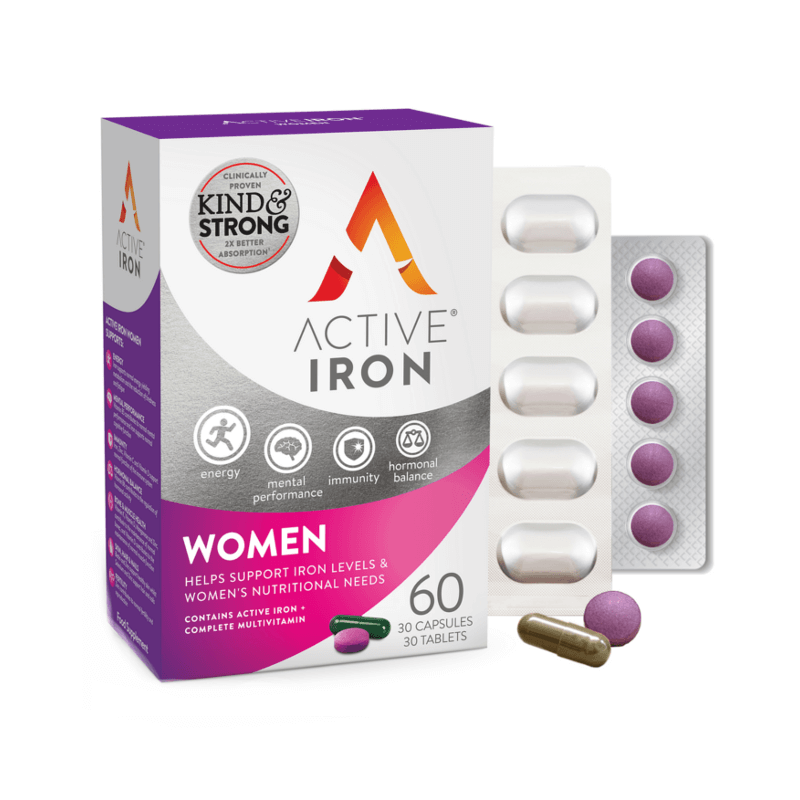Our products.

Active Iron High Potency
Active Iron High Potency is clinically proven to double iron levels and restore energy.

Active Iron for Women
Active Iron for Women helps support iron levels & women’s nutritional needs.



About Active Iron.
Most iron supplements dissolve in the stomach. This can lead to oxidation and gut inflammation, which can lead to common side effects associated with iron supplements, such as constipation and nausea. Active Iron is different. Its ground breaking whey protein formula targets the right place for absorption, the DMT-1. This helps reduce oxidation, thus protecting the gut from inflammation. As a result, Active Iron is highly absorbed compared to other iron supplements³, making it gentle on the stomach and clinical results have shown that it increases iron levels by 94%⁴.
Caroline shares her experience with Active Iron.
Brand Ambassador Caroline Hassett struggled with the side effects of iron supplements before she discovered Active Iron.
If you struggle with the side effects of iron supplements, Active Iron’s Kind & Strong formula can double your iron levels without the common side effects
FAQs.
Why Iron Supplements?
Iron is vital for the formation of red blood cells & hemoglobin for oxygen transportation in the body – which supports energy production. Iron also contributes to normal function of the immune system.
Do you have an iron deficiency?
This affects 2.1 billion men and women worldwide. An iron supplement can help relieve symptoms. Free from artificial colors, preservatives, gluten and sugar.
Why Active Iron?
Active Iron’s high potency, easy to swallow, iron pills are clinically proven to have 2X better absorption of iron sulfate and 6x less gut irritation. It is a non-constipating, gentle iron supplement kind enough to take on an empty stomach.
Who should take iron supplements?
Endurance exercisers & those on restricted diets e.g. vegetarians. Blood donors, women with periods, pregnant & postpartum women. These are easy-to-swallow iron tablets for inadequate iron levels in adult men & women.
How are Active Iron supplements different?
Unlike immediate release iron pills that are broken down in the stomach, Active Iron targets the gut’s natural ‘iron absorber’ site and is released where the iron is better absorbed.
How does Active Iron differ to prescribed iron or liquid iron?
Active Iron is a food supplement and not a medicine, meaning our products contain 100-179% of the recommended daily allowance of iron, whereas prescription iron has a higher dose. For example, prescription iron may contain 100mg elemental iron. The issue with high dose iron is that it oxidises in the gut and as a result it is poorly absorbed (typically just 10% is absorbed). It is this oxidation and poor absorption that causes gastrointestinal side effects such as nausea and constipation in 8/10 people. Typically, 50% of people stop taking iron as a result of these side effects.
Most liquid iron supplements contain a much lower dose of iron which is why they can avoid these common side effects. Although this is a great benefit, they often do not provide sufficient iron to increase iron levels with some only containing 5mg iron per serving.
Active Iron is different. Unlike other oral iron it’s whey protein formula protects the iron from oxidation allowing for 2X better absorption. As a result Active Iron is clinically proven to increase iron levels by 94% and is gentle on the stomach, helping to prevent gastrointestinal side effects and allowing for 4X better compliance in taking the product.
Is Active Iron suitable for pregnant women?
Yes, Active Iron is suitable for pregnant and postpartum women.
Who is Active Iron suitable for?
Active Iron is suitable for those who have or are at risk of having low iron levels. This might include women with heavy periods, pregnant and postpartum women, those with an intolerance to oral iron and those on restricted diets.
¹Pereira D et al BMC Gastroenterol 2014 Jun 4;14:103. doi: 10.1186/1471 230X-14-103.²Tolkien Z, et al. PLOS ONE 2015. ³Wang et al. 2017, Acta Haematologica, 138: 223-232. ⁴Ledwidge et al. 2021. Data on file.


